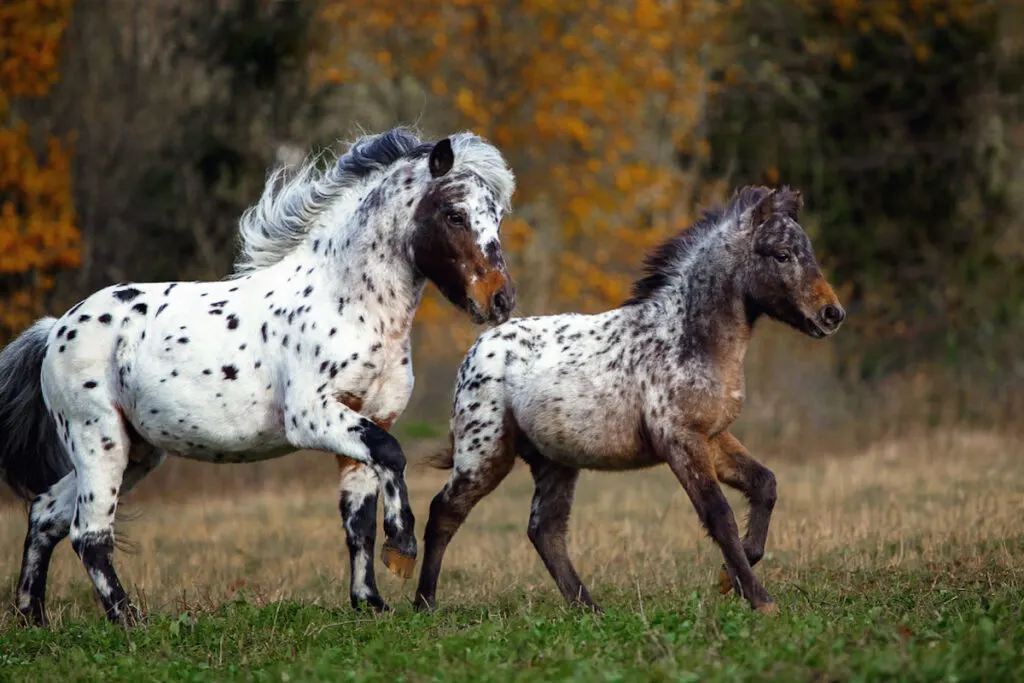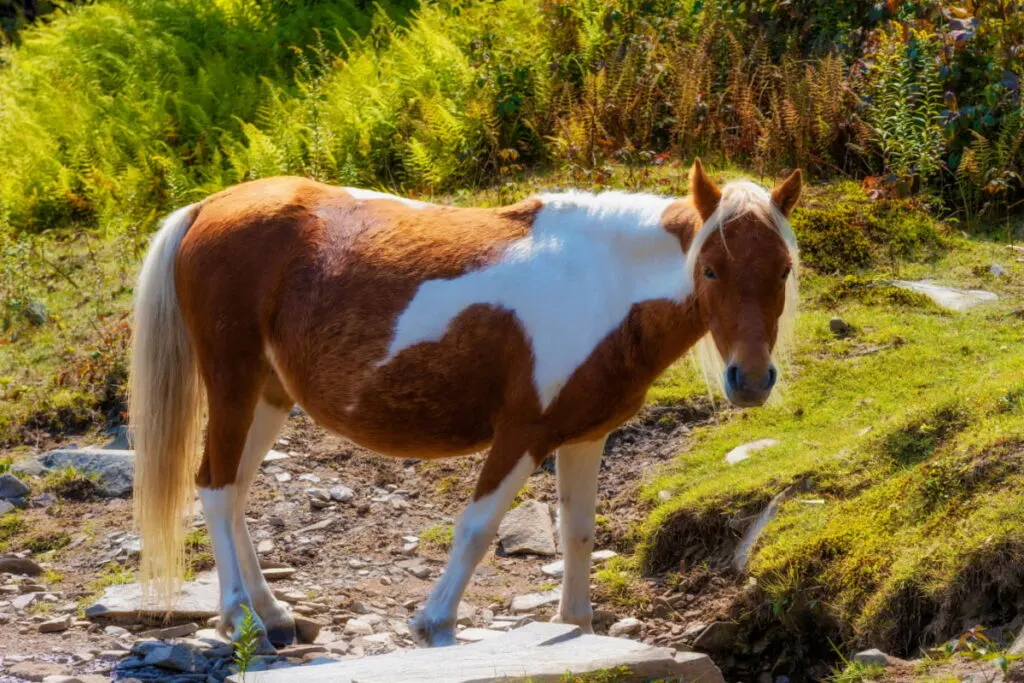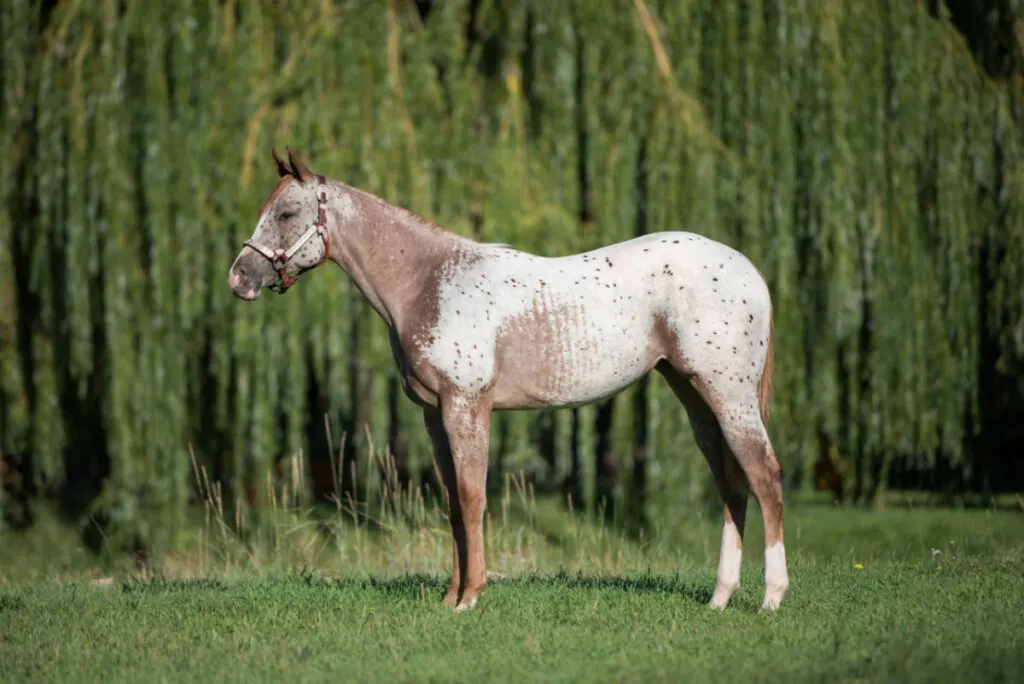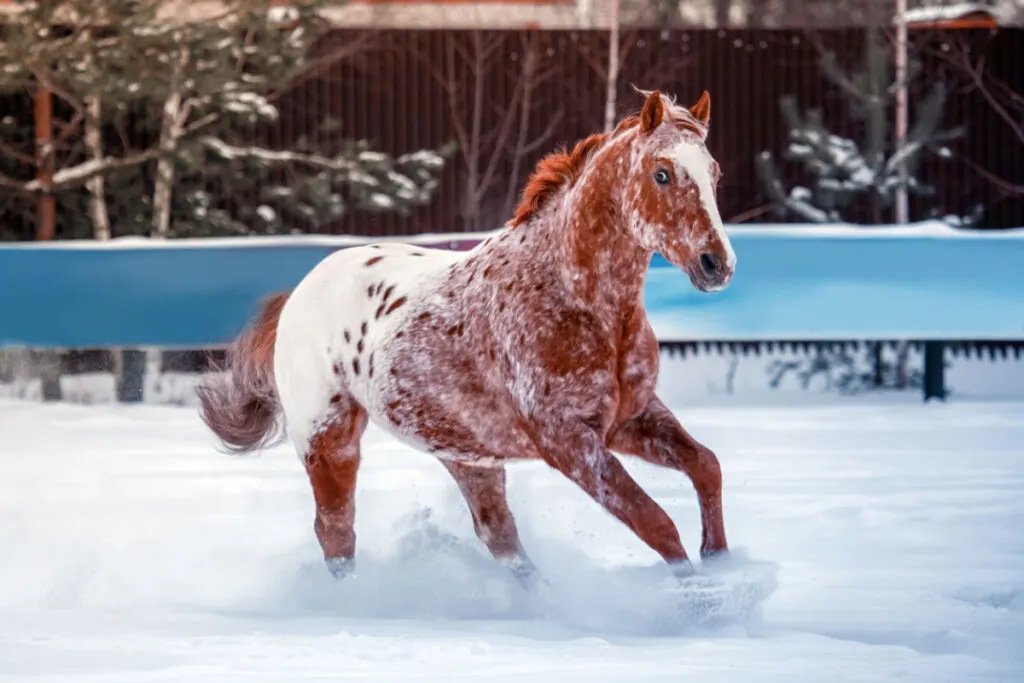The Pony of the Americas is relatively new on the scene compared to many horse breeds. With a registry founded in 1954, this breed has gained popularity quickly. Although these ponies resemble the Appaloosa in their color patterns, they originated from crossing the standard Appaloosa with Shetland Ponies and Arabians.

The result was a smaller equine that maintained the loud coloring of the Appaloosa. The horse world was hooked on this new breed!
Table of Contents
Origins & History
This breed is All-American in origin, with its roots in Iowa! Originally, the founder of the breed, Les Boomhower, created the pony by breeding an Appaloosa/Arabian cross mare with a Shetland Pony stallion.
The result was a colt named Black Hand, the foundation stallion for the breed. Originally, the new breed was for riding strictly by children.
Adults were only allowed to show the POA in-hand or as a cart pony. These newly created ponies allowed child riders who had outgrown small ponies to compete on and enjoy a colorful mount before they graduated to a full-sized horse.
The size of the pony was ideal for children to groom and care for independently. Today, the POA is enjoyed by adults and children alike! This pony breed is versatile and comes in a variety of colors and patterns.
Physical Characteristics
As with many breeds, most POA’s adhere to a certain “type” or breed standard for both height and color.

Height
The original Pony of the Americas had a maximum height requirement of only 52 inches, with a minimum requirement of 44 inches. However, in 1963, the height requirement was increased to a minimum of 46 and a maximum of 54 inches.
By that time, the POA registry was growing rapidly and, by 1996, the registry had over 40,000 ponies recorded.
The Shetland Pony was being utilized less in breeding the POA, and the breed saw the incorporation of Quarter Horses, Welsh Ponies, and Thoroughbreds. (Source)
Color
An important characteristic of the Pony of the Americas is color! A POA is a color breed and should exhibit Appaloosa markings. The ponies come in a variety of patterns (see the table below), but each pony should be distinctly Appaloosa-colored to be registered with the Pony of the Americas Club.
In addition to displaying correct color, ponies must have mottled skin on at least a portion of the body (usually on the muzzle, anus, vulva and/or udder of the mare, and sheath of the gelding) and a white sclera.
A pony can be registered if it exhibits POA type and coloring and has at least one registered parent.
Acceptable Color Patterns of the POA
| Snowflake Pattern | A scattering of small spots throughout the body. Spots must be visible at 40 feet. |
| Blanket Pattern | Dark body color with white spots or areas covering the hip, croup, back, loin or any part thereof. Blankets can contain dark spots. |
| Frost Pattern | Characterized by a light frosting over the back, loin, and croup. White hairs must be mixed into the base coat, and frosting must be visible at 40 feet. |
| Snowcap Pattern | Similar to a blanket, but without any dark spots in the white area. |
| Leopard Pattern | White body with dark spots over the entire body. Spots may be up to four inches in diameter. |
| White with Black Spots on Hindquarters | Basic white body with black spots on loin, hindquarters, croup, back (or part of these areas.) |
| Marbleized/ Varnished Roan Pattern | Roan body color with darker “varnish” on points. Varnish should blend smoothly into the main body. Increased roaning with age is acceptable. |
| Few Spot Leopard Pattern | White body with few or no spots on body. |
| Solid with Dark Spots | Solid body with dark spots. Pony must still show mottling and white sclera. |
Physical Appearance
Ponies of the Americas are not simply a color breed. They are also known for versatility, a gentle disposition, and a lengthy lifespan. They are sturdy, quick, and strong.

Characteristics include a slightly dished face, a trait retained from Arabian influence, a broad chest, and a solid body. The pony should appear as a small horse. (Source)
Disciplines / Use
The POA, although originally perceived as a Western breed, are used in a variety of disciplines today, including trail, endurance, driving, jumping, gaming, halter, ranch work, and hunters.
They are intelligent ponies who tend to be willing learners, and their size makes them an easy choice for children. (Source)
Grooming
Although the Pony of the Americas may require more frequent grooming and bathing to appear clean and well-maintained, they are often easy keepers, requiring very little feed to hold weight.
Their hardy nature allows for the majority of POAs to live in most climates as well as in full turnout or in a stall. They are adaptable, making them a good choice for most families.
Health
Due to the white sclera seen in all Ponies of the Americas, it is imperative for owners to carefully care for the ponies’ eyes.
POAs are prone to uveitis, a condition in which the eye undergoes an inflammatory response characterized by redness, swelling, watering, and squinting.
If left untreated, uveitis can lead to retinal damage, causing blindness.
Owners of a Pony of the Americas should take precautions to protect their pony from excessive sunlight by applying fly masks and utilizing turnout at night or in shaded areas.

Ponies are also susceptible to Congenital Stationary Night Blindness. This is a genetic condition that is non-progressive.
POAs affected by this disease show increased spookiness and a reluctance to move in areas without adequate lighting.
The disease can range in severity, and there is no current treatment. Ponies can be tested for CSNB by a veterinary ophthalmologist. (Source)
Where to Learn More
For those interested in learning more about owning a Pony of the Americas, a great resource would be Pony of the Americas Club.
In addition, there are currently 40 state POA clubs. Clubs offer many events and opportunities for learning about the breed.
In addition, clubs offer awards for a variety of disciplines. The Pony of the Americas can be found readily in most states, so locating the perfect pony for the prospective owner is fairly easy.

